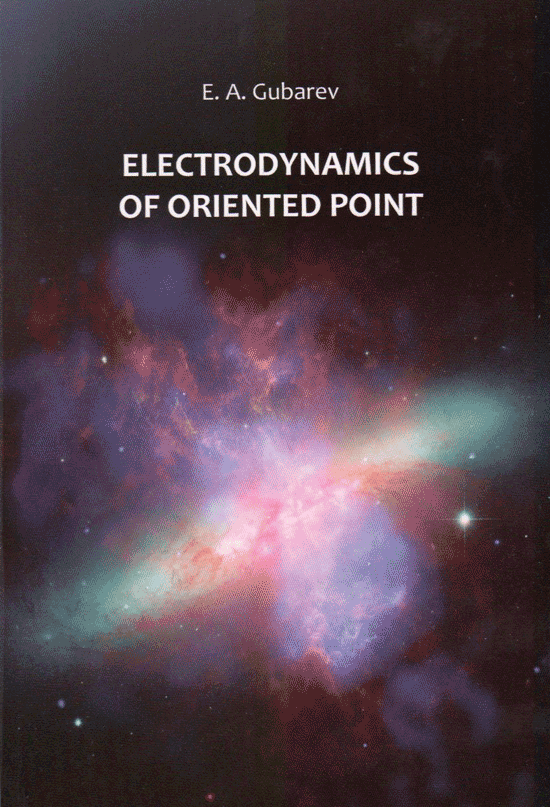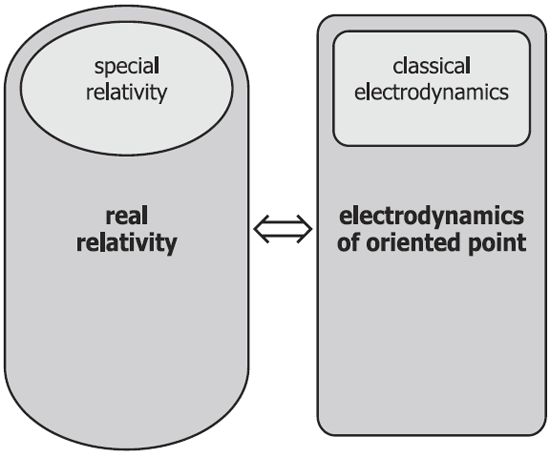|
|
|
E.A. Gubarev
From the editors of AT
A new book by our regular contributor Eugene Gubarev Electrodynamics Of Oriented Point, just published by New Centre, is presented to the attention of our readers.
As stated by the author, a new and more general electrodynamics is based on the principle of real relativity put forward by the author in 2009 (see E.A. Gubarev The Theory of Real Relativity, M.: New Center, 2009). The principle of real relativity proclaims the equivalence of real reference frames (non-inertial reference frames associated with real bodies), and includes Einstein's special principle of relativity as its particular case.
The book presents the basic equations of electrodynamics of the oriented point, which are considered in a number of special cases. The most important of these is the case of the electromagnetic field generated by a charge in a non-relativistic circular motion. It is found that the electromagnetic field generated this way has a number of special properties. In particular, if the angular speed of the charge is considerably higher than the frequency of the monochromatic electromagnetic wave the free electromagnetic field turns out to be a field of a noninductive character and causes no electromotive force across the plane of the wave. This property dramatically differentiates it from the classical free electromagnetic field, which has to vary in time as well as exert an inductive electromotive force in the transverse plane. The considered free electromagnetic field should have a high penetrating power in conductive media (i.e. possess the super permeative ability), since it produces no work upon free charges and, therefore, does not dissipate in conductors.
E. Gubarev has provided Introduction and Final Provisions of the book for publication in AT. You can order the book from http://URSS.ru, an on-line store of scientific literature.

Introduction
A little more than a hundred years ago Albert Einstein changed the view of humanity on the surrounding space having put forward the special principle of relativity [1]. The principle sets up inertial reference frames to be equivalent for the description of events. A. Einstein also showed that there is a complete mutual compliance between the equations of classical electrodynamics and the transformations of coordinates and fields of special relativity.
Consequently, the scope of classical electrodynamics and special relativity is the same — they work for the inertial coordinate system and inertial motion of the charge with an absolute precision. The greater the difference between the motion of a real body and the inertial motion, the greater should be the difference between the real coordinate transformations and the transformations of special relativity. This is shown for the transformations of real relativity [2] between real reference frames, that is, reference frames that are associated with real bodies, whose movements are far from being inertial. The transformations of real relativity are introduced by the author based on the principle of real relativity [2] that establishes the equivalence of real reference frames for the description of physical events.

Figure 1: The ”twin brothers” — special relativity and classical Electrodynamics
Due to the complete conformity of special relativity and classical electrodynamics, one can argue that the extent of disrupting the inertial motion of the charge in the real world corresponds to the extent of disrupting the accurate application of the equations of classical electrodynamics. Therefore, a new generalized electrodynamics should be established for a real noninertial motion of the charge. Following an analogy between the ”twin brothers”, the special relativity and classical electrodynamics (Fig. 1), the new electrodynamics should be based on real relativity principle and consistent with coordinate transformations between real reference frames. A new electrodynamics, along with real relativity, should employ the space of events of the oriented points and a new basic object, a 4D oriented point. Therefore, the new electrodynamics is the electrodynamics of oriented point (Fig. 2).
Here is the list of basic concepts and notations used in this paper.
The space of events of 4D oriented points [3] is used in theory having the property of absolute parallelism. It consists of a database, presenting the world space of spatial and temporal coordinates of oriented points, each of which is associated with a manifold of local coordinates corresponding to orientation angles of an oriented point (fiber). The base coordinates correspond to the index of lowercase letters of the mid alphabet i, j, k, l, m, n, while the coordinates of the fiber correspond to the indices of the lowercase letters of the beginning of the alphabet a, b, c, d, f.
This space of events has a fundamental torsion associated with nonholonomic properties of fiber coordinates. Torsion appears as the asymmetry in the Ricci rotation coefficients in the lower indices ![]() , which are included in the expression for the connection of absolute parallelism
, which are included in the expression for the connection of absolute parallelism ![]() [3].
[3].

Figure 2: To new relativity — new electrodynamics
Electrodynamics of oriented point proposed in this paper seems to be a natural extension of the theory of real relativity [2], which has by now been developed in the following four parts:
Part 1 - kinematics of oriented point,
Part 2 - dynamic relationships,
Part 3 - dynamics of oriented point. Inertia,
Part 4 - electrodynamics of oriented point.
Introduction in PDF (88Кб)
Final Provisions in PDF (42Кб)
E.A. Gubarev, Electrodynamics of oriented point // «Академия Тринитаризма», М.,
|
|